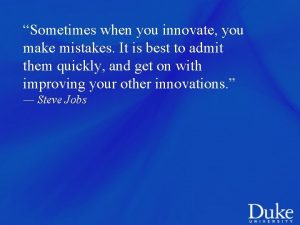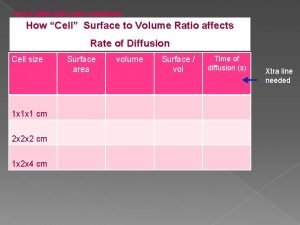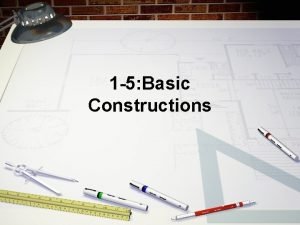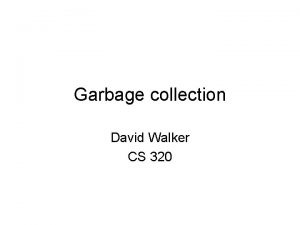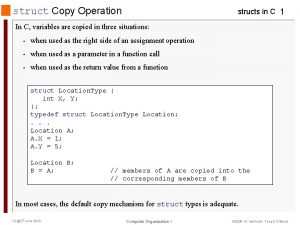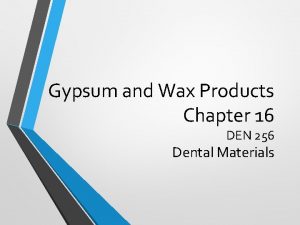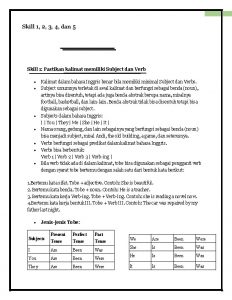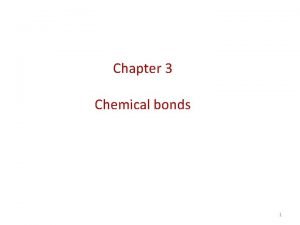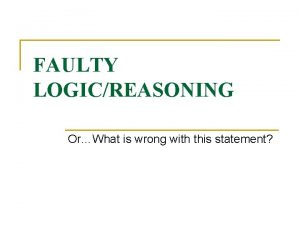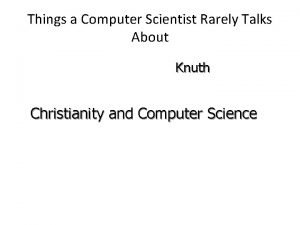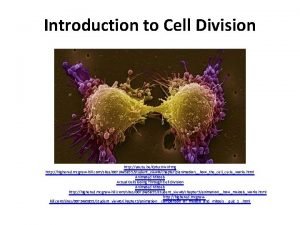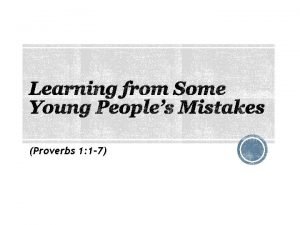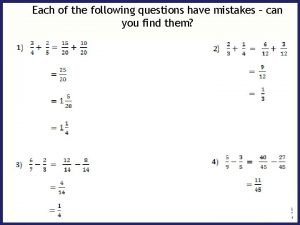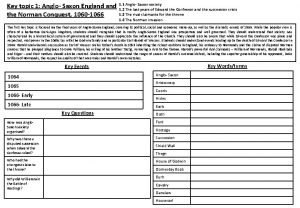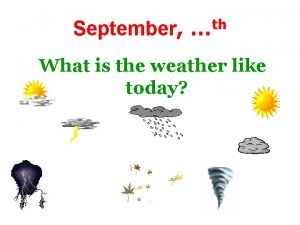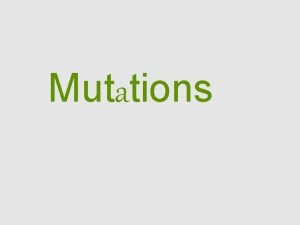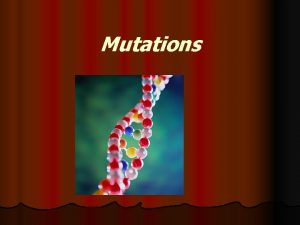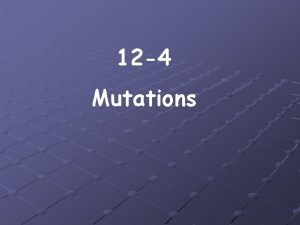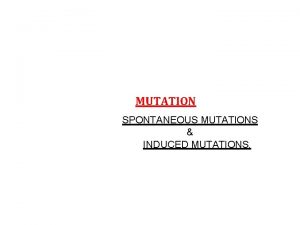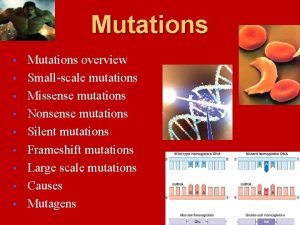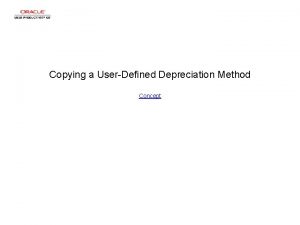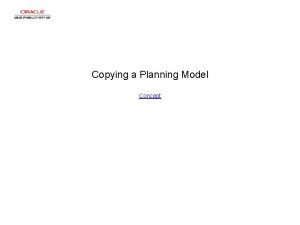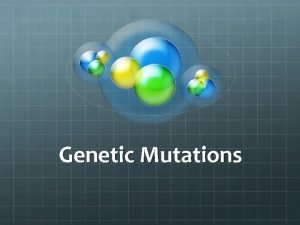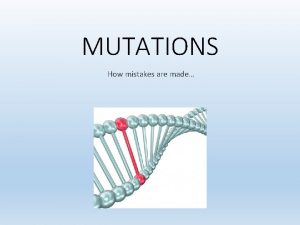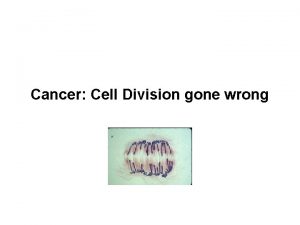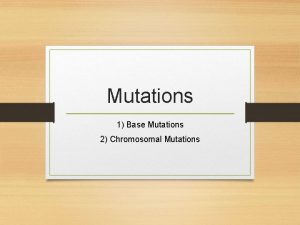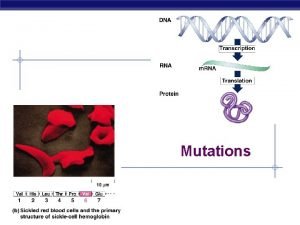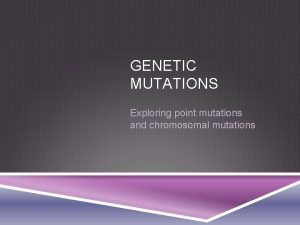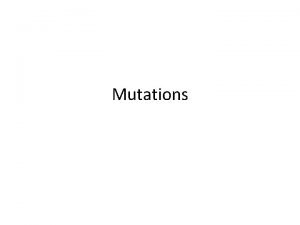Mutations Mutations Cells do rarely make mistakes copying






















































- Slides: 54

Mutations

Mutations Cells do rarely make mistakes copying their own DNA resulting in a change in the DNA. Mutation – a change in genetic material (DNA). There are many types of mutations – we will look at some of them.

Mutations can be spontaneous or can be caused by chemical or physical factors (mutagens). Examples: cigarette smoke, X-rays, benzene, bromines.

Mutations Genetic changes (mutations) can occur in either somatic (body) cells or in germ cells (cells that will give rise to gametes). Somatic cell mutations only affect the cells that are produced by mitosis from the mutant cell. This can be important (e. g. cancer) but does not get passed on to the individual’s offspring.

Mutations Germ cell mutations are incorporated into gametes (sperm or eggs). All of the cells of the new organism resulting from the joining together of the mutant gamete with another gamete will have the new genetic composition (mutation). Germ cell mutations are inherited (passed down to offspring).

Mutations - types Gene mutations – mutations that produce changes in a single gene. Point mutations – gene mutations that involve changes in only one (or a few nucleotides). Substitutions – a different nucleotide Insertions – an extra nucleotide Deletions – a missing nucleotide

Effects of *Point Mutations* Substitutions – usually affect only a single amino acid. Recall that there is actually some redundancy in the genetic code. Most amino acids have more than one codon that codes for them. ex. Proline is coded for by CCU, CCC, CCA and CCG.


Effects of Point Mutations If the change is in the third base of the codon, there is frequently no change in the amino acid sequence. This means that if there is no change in the amino acid sequence, there is NO EFFECT on the protein coded for by that gene and NO EFFECT on the organism.

Effects of Point Mutations If the single change causes a different amino acid to be coded for, ex. CAC (histidine) changed to CAG (glutamine), then this one small change may significantly change the shape or bonding characteristics of the protein. The protein may no longer work effectively.

One point mutation is all that is takes to cause the sickle cell allele (abnormal hemoglobin protein).

Results of mutations Can be very harmful (death or disease) Can be neutral (neither harmful nor good) or not too much different from normal. Rarely, mutations may prove to be useful to the organism and be passed on to offspring. All the different alleles present in gene pools are there because of mutations. This is the raw material on which natural selection acts.

Effects of Point Mutations Substitutions – usually affect only a single amino acid. Insertions and deletions are often more dramatic—changing the groupings of the bases. This is called a frameshift mutation. AGC CA GTC CCG GTT deletion

*Frameshift* mutation example Thecatatetherat If read like a ribosome reads it (1 codon, 3 “letters” at a time) The cat ate the rat If the 3 rd letter is deleted… Thecatatetherat �Thcatatetherat Now the line is read… Thc ata tet her at ? ? ? Everything downstream from the mistake is affected.

**Chromosomal Mutations** E E Changes in the number or structure of chromosomes. Larger-scale change than point mutations.

Chromosomal Mutations E Duplication – part of a chromosome is copied and added to the chromosome.


Chromosomal Mutations Deletion – part of the chromosome (some of its genes) are lost from the chromosome.


Chromosomal Mutations E Inversion – a piece of the chromosome is snipped out and then reattached – only in the reverse direction.


Chromosomal Mutations E E Translocation – a piece of one chromosome is attached to a another chromosome. Often, two non-homologous chromosomes trade pieces with each other.


Chromosomal Mutations E E E The largest change in the DNA of an organism is a change in the number of chromosomes it has. One can observe these changes in a karyotype. A karyotype is a visual representation of the chromosomes of an organism.

Mouse Karyotype

Dog Karyotype

He. La Karyotype

Meiosis – Begin with one diploid germ cell and produces, after two rounds of division, four haploid gametes.

Errors in meiosis Occasionally, there are errors in meiosis resulting in the wrong number of chromosomes in the gametes. Aneuploid – having an abnormal number of some chromosome.

Errors in meiosis Monosomic – Only one of some homologous pair (too few) Trisomic – Three of some homologue (too many)

Errors in meiosis The primary cause of these irregular chromosome numbers is nondisjunction – the failure of chromosomes to separate correctly in Anaphase I or Anaphase II of meiosis.

The gametes should all have one chromosome for this example (2 n = 2, n =1).

The gametes should all have one chromosome for this example (2 n = 2, n =1).

*Nondisjunction* in humans The most common observable condition in humans related to nondisjunction is Down Syndrome. This is caused by Trisomy 21(three copies of chromosome 21). With only a couple of other rare exceptions, trisomies of autosomes in humans are not viable. Fertilizations involving monosomic gametes (one too few) do not survive.

Down Syndrome Down syndrome affects approximately one out of every 700 children born in the U. S. All body cells have 47 chromosomes (3 chromosome 21's) Down syndrome causes characteristic facial features, short stature, and developmental delays. Increased incidence of leukemia, Alzheimer's Decreased rates of high blood pressure, hardening of the arteries, many types of solid tumors.

Trisomy 21 (Down Syndrome) female

Trisomy 21 (Down Syndrome) - male

Chromosomal mutations Plants have a much simpler developmental plan than do animals. Plants are more immune to the genetic disruption caused by many types of mutations.

Chromosomal mutations One common type of chromosomal mutation in plants is polyploidy. Polyploidy is the multiplication of entire sets of chromosomes (four, six, eight sets of chromosomes instead of the usual two (diploid) Polyploids are often larger and more vigorous than their diploid relatives (ancestors).

Allopolyploid




Effects of Point Mutations Insertions and deletions are often more dramatic—changing the groups the bases are read in. This is called a frameshift mutation. AGC TCA GTC CCG GTT

Effects of Point Mutations frameshift mutation. AGC CA GTC CCG GTT deletion Now the codons are read: AGC CAG TCC CGG TT? etc. Every codon past the frameshift mutation is affected (changed). The protein will probably be altered so much that it no longer functions.





Chromosomal Mutations Deletion Duplication Inversion




 Top 10 mistakes pastors make
Top 10 mistakes pastors make 13 fatal errors managers make
13 fatal errors managers make We all make mistakes
We all make mistakes Four mistakes leaders keep making
Four mistakes leaders keep making Sometimes mistakes ... (make)
Sometimes mistakes ... (make) Copy the table into your notebook
Copy the table into your notebook Replication process
Replication process Copying an angle
Copying an angle Copying gc
Copying gc Copying structs in c
Copying structs in c Evil of copying
Evil of copying Staples production center
Staples production center Prokaryotic cells
Prokaryotic cells Eukarya
Eukarya Masses of cells form and steal nutrients from healthy cells
Masses of cells form and steal nutrients from healthy cells Somatic vs gamete
Somatic vs gamete Thyroid gland
Thyroid gland Chapter 8 cellular reproduction cells from cells
Chapter 8 cellular reproduction cells from cells Plant vs animal cell venn diagram
Plant vs animal cell venn diagram Pseudostratified vs simple columnar
Pseudostratified vs simple columnar Why dna is more stable than rna
Why dna is more stable than rna Cells cells they're made of organelles meme
Cells cells they're made of organelles meme Prokaryotic cells
Prokaryotic cells Submentovertical projection
Submentovertical projection Prokaryotic cells vs eukaryotic cells
Prokaryotic cells vs eukaryotic cells Red blood cells and white blood cells difference
Red blood cells and white blood cells difference Cell organelle jeopardy
Cell organelle jeopardy Tubular lumen
Tubular lumen Die stone composition
Die stone composition Sarah rarely misses her basketball shots
Sarah rarely misses her basketball shots Nno resonance structures
Nno resonance structures Always usually often sometimes
Always usually often sometimes Faulty logic statements examples
Faulty logic statements examples Why is canada rarely impacted by natural weather hazards
Why is canada rarely impacted by natural weather hazards Things a computer scientist rarely talks about
Things a computer scientist rarely talks about What do cells make up
What do cells make up Phase
Phase Make the lie big, make it simple
Make the lie big, make it simple Make the lie big, make it simple
Make the lie big, make it simple Steve angrisano go make a difference
Steve angrisano go make a difference Harolds mistakes in the battle of hastings
Harolds mistakes in the battle of hastings Bell ringer monday mistakes
Bell ringer monday mistakes Spitting in clients soup
Spitting in clients soup A computer makes mistakes true or false
A computer makes mistakes true or false Proverbs about learning from mistakes
Proverbs about learning from mistakes Each of the following answers has two mistakes
Each of the following answers has two mistakes Harolds mistakes in the battle of hastings
Harolds mistakes in the battle of hastings Computer waste and mistakes
Computer waste and mistakes Biggest mistakes product management
Biggest mistakes product management The man makes all the following mistakes except
The man makes all the following mistakes except Onomatopoeia song lyrics
Onomatopoeia song lyrics Worst email mistakes
Worst email mistakes Find six mistakes in robin's spelling test
Find six mistakes in robin's spelling test Annuity mistakes to avoid
Annuity mistakes to avoid 10 common communication mistakes
10 common communication mistakes




